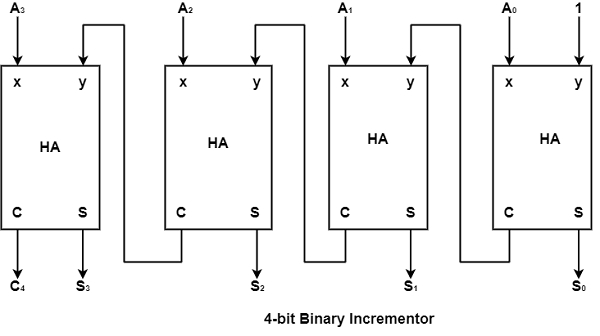
 Data Structure
Data Structure Networking
Networking RDBMS
RDBMS Operating System
Operating System Java
Java MS Excel
MS Excel iOS
iOS HTML
HTML CSS
CSS Android
Android Python
Python C Programming
C Programming C++
C++ C#
C# MongoDB
MongoDB MySQL
MySQL Javascript
Javascript PHP
PHP
- Selected Reading
- UPSC IAS Exams Notes
- Developer's Best Practices
- Questions and Answers
- Effective Resume Writing
- HR Interview Questions
- Computer Glossary
- Who is Who
What is Binary Incrementer in Computer Architecture?
The increment micro-operation inserts one to a number in a register. For example, if a 4-bit register has a binary value 0110, it will go to 0111 after it is incremented. The increment micro-operation is performed by a 4-bit combinational circuit incrementer.
This micro-operation is simply performed with a binary counter. Each time the count allowed is active, the clock pulse transition increments the content of the register by one. There can be occasions when the increment micro-operation should be completed with a combinational circuit independent of a specific register. This can be done using half-adders connected in cascade.
The diagram of a 4-bit combinational circuit incrementer is demonstrated in the figure.

One of the inputs to the least significant half-adder (HA) is connected to logic-1. The other input is linked to the least significant bit of the number to be incremented.
The output carry from one half-adder is linked to one of the inputs of the next-higher-order half-adder. The circuit gets the four bits from , A0 by A3 , inserts one to it, and produces the incremented output in S0 through S3.
The output carries C4 will be 1 only after incrementing binary 1111. It can also generate outputs S0 through S3, to go to 0.
The circuit of a diagram can be continued to an n-bit binary incrementer by continued the figure to contain n half-adders.
The least significant bit must have one input linked to logic-1. The other inputs receive the number to be incremented or the carry from the previous stage.

